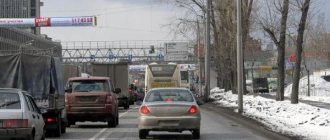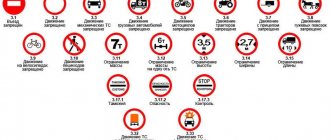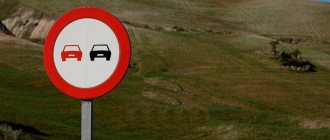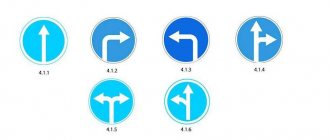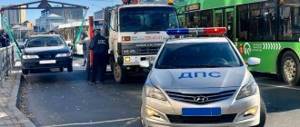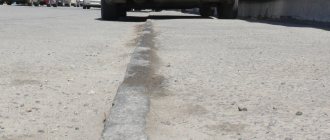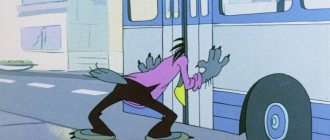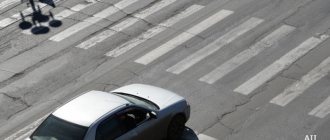Characteristics of the sign
“Entry prohibited” is a symbol that indicates that further movement of the vehicle is unacceptable. A brick marks a section of the road where the movement of a car is partially or completely prevented in a particular direction. However, this requirement does not apply to all types of vehicles. Some cars are allowed into the restricted area, and drivers are not punished with fines or other measures.
In what cases is it installed
A sign identifies a section of the road on which traffic should be limited. The law does not clearly describe in what situations a prohibitory symbol must be present.
Among the most common cases are the following:
- Reverse direction on one-way roads;
- Entry into areas where only route vehicles are allowed to travel;
- Driving through areas that cannot be reached from the direction where the sign is installed.
“No Entry” is often used in businesses to prevent unauthorized movement within the area. In such cases, the installation of the symbol must be carried out with simultaneous approval from the traffic police. Otherwise, it may be considered invalid and no one will receive a punishment for driving under a brick.
Important points
Car owners have something to think about, because everything depends on the punishment received for driving under a prohibitory sign, popularly called a “brick.”
Since there is a very noticeable difference between a fine and deprivation of the right to drive a car. And perhaps that is why drivers often ignore this sign, hoping that “maybe it will blow by.”
However, this is a serious misconception, since the traffic rules say that entry is prohibited for all vehicles.
Why do some violators go to court and what can they prove? For example, that the sign itself was not installed according to the rules. By the way, signs are installed in the city and outside the city according to different rules.
What you need to know
Punishment for driving under traffic rules sign 3.1 may follow if it is installed:
| In the city at a distance of 25 meters before the beginning of the road section | For which it is intended. Its installation height should be 2-4 meters |
| Outside the city, at least fifty meters before the designated area | Installed at a height of 1.5 to 3 meters |
| On the side of the road | At a distance of at least 50 cm from the edge of the road |
The specified parameters for installing the “brick” are important, since they may be the only confirmation that the driver did not commit a violation or committed it for reasons beyond his control.
These include:
- the sign is not visible because it is blocked by the crown of trees;
- the visibility of the sign is blocked by a billboard, banner or building;
- the sign is installed at a distance that does not allow a timely response to it.
In what cases is a sign installed?
To restrict passage, a “brick” can be installed:
| On certain road sections | As a traffic restriction |
| In parks, green areas, parking lots, gas stations, parking lots | To separate exits and entrances and organize directions of traffic flows |
| In megacities with high traffic congestion | To limit the passage of public transport in certain areas, for route buses and trolleybuses - entire lanes |
| On the territories of institutions | For the passage of departmental and special transport (medical, fire fighting) |
| On one-way roads | To prohibit leaving and driving in the oncoming lane, to prevent a U-turn - at the end of a road section that has a one-way direction of movement. On several such lanes, a sign is installed on each of the lanes |
Regulatory regulation
In Russian legislation, several regulations regulate the installation and use of “No Entry” signs:
| Sign 3.1 “Entry prohibited” – refers to prohibition signs | In accordance with Chapter 3 of the Traffic Regulations of the Russian Federation |
| Rules for the use and installation of road signs | Defined by the National Standard of the Russian Federation GOST R 52289-2004 |
| Penalties for drivers who do not comply with road signs | Provides for Article 12.16 of the Code of Administrative Offenses of the Russian Federation |
| A 10-day period for appealing decisions on administrative violations is provided | In accordance with Article 30.3 of the Code of Administrative Offenses of the Russian Federation |
| Cases in which administrative punishment is imposed without drawing up a protocol | Regulated by Article 28.6 of the Code of Administrative Offenses of the Russian Federation |
| Rules for imposing punishment, taking into account the nature of the violation, the personality and financial situation of the offender, mitigating and aggravating circumstances | Regulates part 2 of article 4.1 of the Code of Administrative Offenses of the Russian Federation |
| Pay half of the fine imposed for driving under a “brick” | Allows Federal Law No. 437 dated December 22, 2014 |
Grounds for fine
There are different ways to violate traffic rules regarding driving under a brick. Further punishment for the illegal action depends on this. Sometimes the driver is only warned. It is recommended to consider several cases in which the owner of a vehicle will face a fine for a brick in 2021.
These include:
- Driving through the surrounding area. Drivers often ignore the symbol that prohibits driving to a parking lot or gas station. Despite the fact that these areas are not the main road, they are also marked and regulated by signs. In this case, the amount of the fine for violation reaches 500 rubles.
- Driving in the oncoming lane. On roads where traffic is one-way, a brick is installed as a warning signal. If the driver neglects the ban, the fine can reach 5 thousand rubles.
Amounts of fines
The size of the sanction varies depending on the specifics of the violation. Obviously, the penalty is greater in cases where failure to comply with traffic rules creates dangerous conditions for other road users. The average fines for driving under a brick are discussed below.
| Nature of the violation | Recovery amount (RUB) |
| Driving on single-lane roads against the direction of general traffic | 5 thousand |
| Entering a yard or parking lot under a prohibitory sign | 500 |
| Driving in a bus lane | 1500 |
| Driving under a prohibiting sign to a place of work | 500 |
The fine for driving under a “No Through” sign varies based on numerous factors. It can be extremely difficult for drivers to understand the nature of the violation, especially if traffic police officers do not support this with the relevant articles from the Code of Administrative Offenses. Therefore, in case of illegal actions, the inspector issuing a fine is obliged to notify the exact reason, indicating the nature of the violation.
Fine for driving under a brick sign
The amount of the fine that may be imposed on you if you drive under the Brick depends on many factors.
Its value is influenced by:
- whether this illegal act led to serious consequences. That is, whether a traffic accident occurred as a result of your passage under the “Brick”;
- the frequency with which you commit traffic violations;
- It also matters how exactly the fact of your committing this illegal act was recorded: it was recorded by a traffic police officer;
- the fact that you committed an illegal act was recorded using automatic photo and video recording equipment.
How dangerous the unlawful act you committed, expressed in driving under the “Brick”, was to others is determined solely by the traffic police officer.
At the same time, he is obliged to record this data in the protocol, which is drawn up upon the fact of the administrative offense you committed.
It is worth understanding that all information entered into the protocol will be used as evidence during the trial.
In addition to the protocol, the court may accept as evidence:
- duly prepared testimony of citizens who suffered as a result of the unlawful act you committed;
- duly prepared testimony of citizens who were witnesses;
- materials obtained using automatic photo and video recording of offenses;
- The court may also accept for consideration materials received from the DVR installed in your vehicle.
This year, the following fines have been established for driving under the “Brick”:
- For entering the area in front of which the “Brick” is installed, you will be fined in the amount of 500 rubles. This minimum fine is established on the basis that the offense is minor and does not have harmful consequences;
- if you entered a dedicated lane intended for public transport and in front of which there is a corresponding sign, then the fine for you will be 1,500 rubles. If you commit this violation in cities of federal significance, then you will have to replenish the budget of the Motherland by 3,000 rubles;
- a much more severe punishment will overtake you if, having passed under the “Brick”, you end up in oncoming traffic. After all, by committing this illegal act, you risk causing an accident. For committing it, you may be deprived of the right to drive vehicles for a period of four to six months.
It is worth noting that you will be very lucky if the fact that you committed an illegal act, as a result of which you, having driven under the “Brick”, ended up in oncoming traffic, was recorded by means of automatic photo and video recording of offenses.
Based on materials obtained through such means, you cannot be deprived of the right to drive motor vehicles. However, you will have to pay a fairly large fine, the amount of which is 5,000 rubles.
Please note that you will be held accountable for driving under the “Brick” regardless of how you committed this offense: by continuing to move straight, or by reversing.
We emphasize that if you commit a repeat offense, you will be punished by deprivation of the right to drive vehicles for a period of one year.
If your repeated driving under the “Brick” is recorded by means of automatic photo and video recording of offenses, then you will only get off with a fine. In this case, by replenishing the state treasury by 5,000 rubles, you will retain the right to drive vehicles.
What is the fine for driving under a brick? What is the fine for driving on one-way traffic, read here.
Find out about the fine for driving under a brick on the wrong side of the road at the following link:
Additional penalties
In case of gross violations of traffic rules, especially when driving on a single-lane road against the direction of travel, in addition to a fine, the driver may be subject to other types of liability. We are talking about deprivation of rights for a period of 4-6 months.
Attention! If the violation was recorded repeatedly using surveillance cameras or other means of video recording, the ID may be confiscated for up to 1 year. At the same time, the owner of the car is obliged to pay a fine of 5 thousand rubles. Similar penalties are used in a situation where an unlawful action was recorded by a traffic police inspector.
Is it possible to challenge
There are ways to prevent a fine or deprivation of your license for driving under a brick in 2021. This method works in cases where the sign was installed incorrectly. In this situation, the driver can appeal the decision, citing the fact that he did not notice the prohibiting symbol.
In accordance with GOST, the “brick” must be located in a visibility zone of at least 100 m. The distance from the road is no more than 2 m, and the height is no higher than 3 m. If these requirements are not met, the offender has the opportunity to challenge the fine. This can be done immediately upon registration. Another way is to file a complaint with the traffic police at your place of residence.
How to challenge a fine and when to do it
If a court decision has already been made, it will be quite difficult to challenge it, so it is worth presenting all the evidence on the controversial issue during the trial. Sometimes the costs of legal services will exceed the amount of the fine imposed, so think about whether it is worth it. But if you are threatened with deprivation of your driver’s license, then be sure to go to court and seek a fair punishment. The following steps should be strictly observed and followed:
- do not sign the protocol drawn up, as this will be perceived as an admission of guilt, in which case it will not be possible to challenge it;
- make sure that the inspector has made a mark indicating that the driver does not agree with the punishment imposed on him for a significant reason, for example, because the sign is installed incorrectly or is difficult to see;
- if the driver does not know the exact standards, it is worth consulting with knowledgeable specialists (lawyer or lawyer);
- you must submit an application to the court within 10 days from the date of drawing up the protocol, which indicates the reason for disagreement with the punishment;
- A certain list of documents must be attached to the application; the full list can be checked with a lawyer;
- collect evidence, if possible: photos or videos from the scene of the incident, invite witnesses, if any;
- carefully read the protocol to find errors in its preparation.
You need to have good reasons to challenge the record, otherwise you will lose in court.
Note!
The applicant does not need to pay a state fee to appeal the decision.
What categories of vehicles can drive under a brick?
There are a number of exceptions in which cars can drive despite a prohibitory sign. This requirement does not apply to certain categories of vehicles. These include:
- Route and passenger vehicles;
- Cars that are used to transport disabled people;
- Vehicles used in private enterprises;
- Car owners who are residents of the area under the prohibited sign;
- Special equipment and trucks that unload materials during construction, repair or installation work;
- Emergency vehicles and mail.
Driving on a section of road that is marked with a prohibitory sign is considered an offence. This is subject to administrative liability, a fine, and in some situations, deprivation of rights. To prevent punishment, drivers should know when driving under a brick is not prohibited.
Under what conditions is a driver's license revoked?
A motorist may be deprived of the right to drive a vehicle the first time he enters a one-way road. The time frame will be from 4 to 6 months. Such sanctions are applied quite rarely, and fines are imposed instead.
A guaranteed deprivation of rights awaits the driver if he has previously violated a similar rule. When recorded by cameras, the liability is lighter - the standard fine is 5,000 rubles. But the inspector who stopped the violator will definitely deprive him of his rights for 1 year. There are no exceptions or the possibility of choosing a punishment in such circumstances.
Important! Inexperienced drivers do not know the dangers of driving under the “brick” sign. Unscrupulous inspectors take advantage of this by imposing fines instead of 500 rubles. size 5000 rub.
From the video you will learn what the dangers of driving through a prohibitory sign are:

